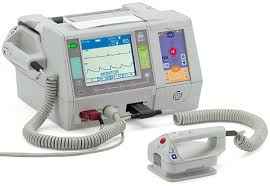
Defibrillation is a common treatment for life-threatening cardiac dysrhythmias and ventricular fibrillation. Defibrillation consists of delivering a therapeutic dose of electrical current to the heart with a device called a defibrillator. This depolarizes a critical mass of the heart muscle, terminates the dysrhythmia and allows normal sinus rhythm to be reestablished by the body's natural pacemaker, in the sinoatrial node of the heart.
Defibrillators can be external, trans venous, or implanted (implantable cardioverter-defibrillator), depending on the type of device used or needed. Some external units, known as automated external defibrillators (AEDs), automate the diagnosis of treatable rhythms, meaning that lay responders or bystanders are able to use them successfully with little or no training.
Medical uses
In a study of CPR and defibrillation for cardiac arrest under ideal conditions, survival with normal neurological function occurred is 38%. Assuming survival without defibrillation to be zero, this is equivalent to saving the life of 2 out of 5 people using defibrillation. Furthermore, when considering only those with a heart rhythm correctable by defibrillation (ventricular fibrillation), survival rate was 59%, equivalent to saving 3 out of 5. Survival rates from cardiac arrest was less, however, in more common circumstances seen outside of the study, including among ill hospitalized persons, people without access to immediate (<4–5 minutes) CPR, and for those whose arrest is not witnessed.
Manual external defibrillator
The units are used in conjunction with electrocardiogram readers, which the healthcare provider uses to diagnose a cardiac condition. The healthcare provider will then decide what charge (in joules) to use, based on proven guidelines and experience, and will deliver the shock through paddles or pads on the patient's chest. As they require detailed medical knowledge, these units are generally only found in hospitals and on some ambulances.
Manual internal defibrillator
These are the direct descendants of the work of Beck and Lown. They are virtually identical to the external version, except that the charge is delivered through internal paddles in direct contact with the heart. These are almost exclusively found in operating theatres (rooms), where the chest is likely to be open, or can be opened quickly by a surgeon.
Automated external defibrillator (AED)
These simple-to-use units are based on computer technology which is designed to analyze the heart rhythm itself, and then advise the user whether a shock is required. They are designed to be used by lay persons, who require little training to operate them correctly. They are usually limited in their interventions to delivering high joule shocks for VF (ventricular fibrillation) and VT (ventricular tachycardia) rhythms, making them generally of limited use to health professionals, who could diagnose and treat a wider range of problems with a manual or semi-automatic unit.
The automatic units also take time (generally 10–20 seconds) to diagnose the rhythm, where a professional could diagnose and treat the condition far more quickly with a manual unit.
Automated external defibrillators are generally either held by trained personnel who will attend incidents, or are public access units which can be found in places including corporate and government offices, shopping centers, airports, restaurants, casinos, hotels, sports stadiums, schools and universities, community centers, fitness centers and health clubs.
There are 2 types of AEDs: Fully Automated and Semi Automated. Most AEDs are semi-automated. A semi-automated AED automatically diagnoses heart rhythms and determines if a shock is necessary. If a shock is advised, the user must then push a button to administer the shock. A fully automated AED automatically diagnoses the heart rhythm and advises the user to stand back while the shock is automatically given. Also, some types of AEDs come with advanced features, such as a manual override or an ECG display.
Implantable cardioverter-defibrillator (ICD)
Also known as automatic internal cardiac defibrillator (AICD). These devices are implants, similar to pacemakers. They constantly monitor the patient's heart rhythm, and automatically administer shocks for various life-threatening arrhythmias, according to the device's programming. Many modern devices can distinguish between ventricular fibrillation, ventricular tachycardia, and more benign arrhythmias like supraventricular tachycardia and atrial fibrillation. When the life-threatening arrhythmia is ventricular fibrillation, the device is programmed to proceed immediately to an unsynchronized shock.
Wearable cardiac defibrillator
A development of the AICD is a portable external defibrillator that is worn like a vest. The unit monitors the patient 24 hours a day and will automatically deliver a biphasic shock if needed. As of February 2011 only one company manufactures these portable external defibrillators and they are of limited availability.
 English
English فارسی
فارسی